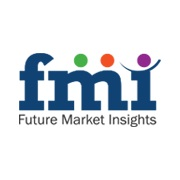Lab Automation Market Is Projected to Grow at a High CAGR of 9.6% by 2027
Due to the dominant features and advantages, lab automation is preferred by the diagnostics industry, followed by drug discovery and research labs. Lab automation has a wide variety of applications in life sciences, ranging from clinical pathology to molecular research.

Valley Cottage, NY -- (SBWire) -- 04/29/2019 --According to a recent market report published by Future Market Insights titled, 'Lab Automation Market – Global Industry Analysis and Opportunity Assessment, 2017–2027', the global lab automation market is expected to be valued at US$ 1,219.4 Mn in 2017, and is expected to register a CAGR of 9.6% from 2017 to 2027. Lab automation is increasingly being installed by various end users such as pharmaceutical companies, hospitals and diagnostic centers, educational institutions, contract research organizations (CROs), and research institutes. There has been an increase in the usage of lab automation components in hospitals and diagnostic centers, due to an increase in the demand for biochemistry devices.
Dynamics of the Global Lab Automation Market
Increasing incidences of life threatening diseases and injuries have led to increasing diagnostics procedures, worldwide. It is estimated that, the direct and indirect costs of diagnosis will increase over a period of time. The rising research and development activities in the field of molecular and genetics, biochemistry, microbiology, and immunology have also boosted the demand for accurate and cost saving facilities. To develop cost-effective and cost-efficient medical devices and lab automation services, various governments in developed countries are actively funding R&D activities. For instance, the New South Wales (NSW) government in Australia, has provided a medical devices fund of around US$ 8.0 million in 2017-2018 to help encourage and support investments in the development and commercialization of medical devices, related technologies, and services.
Favourable government policies for start-ups enable companies to develop cost-effective healthcare solutions in the lab automation market. Over the last few years, government authorities in Asia Pacific and Middle East and Africa are encouraging start-up companies as well as MNCs to boost industrial growth in the healthcare and medical device industries. Major players in the in-vitro diagnostics market can capitalize on the economies of scale to strengthen their position in the market.
Request to View Sample of Research Report @ https://www.futuremarketinsights.com/reports/sample/rep-gb-394
For instance, India, a developing country in the Asia Pacific region, has announced new policies for attracting MNCs as well as start-up companies across domains, including medical device manufacturing. According to the policies, start-up companies in India are exempt from tax for the first three years after establishment, and patent protection costs are subsidized. Thus, favourable government policies in developing countries are expected to drive overall the lab automation devices and services market.
However, the complex integration of lab tools hinders the demand for lab automation solutions. Lab professionals are focusing on the better utilization of test tools, consolidating various resources and deploying effective lab tools across all platforms. Interconnecting various platforms across the lab is a very critical task, and needs advanced PR-PR open-source high-level robot programming language as a cross-platform laboratory automation system, which may lead to complexity and a variety of test configurations, and restrain the growth of the lab automation market over the forecast period.
Global Lab Automation Market: Segmentation & Analysis
On the basis of component, the global lab automation market is segmented into devices and software. Further, the devices segment has been segmented into six categories – biochemistry devices, molecular devices, hematology devices, immunology devices, microbiology devices, and others. The software segment is bifurcated into two segments scheduling software and momentum integration software.
On the basis of application, the lab automation market is segmented into life sciences research & development, drug-discovery, and diagnostics, in terms of revenue share. The life Sciences R&D segment dominated the global lab automation market in 2017, and is expected to do so throughout the forecast period. The diagnostics application segment is anticipated to expand at the fastest CAGR over the forecast period.
On the basis of end user, the global lab automation market is segmented into pharmaceutical companies, hospitals and diagnostic centers, educational institutions, contract research organizations (CROs), and research institutes. The hospitals and diagnostic centers segment currently accounts for the highest revenue share in the lab automation market, due to the increasing usage of automation devices in hospitals and diagnostic centers in developed countries.
This lab automation market report also covers trends that drive each segment, and offers analysis and insights regarding the potential of the lab automation market in regions such as North America, Latin America, Western Europe, Eastern Europe, APEJ, Japan, Middle East & Africa, and Japan. Among these regions, the North American lab automation market is projected to exhibit relatively high growth in the global lab automation market, with a CAGR 10.6% over the forecast period. Revenue from the lab automation market in North America is estimated to account for over 37.1% of the global lab automation market revenue in 2016. Lab automation solution providers can focus on expanding across several countries in North America, such as the U.S. and Canada.
Need more information about Report methodology @ https://www.futuremarketinsights.com/askus/rep-gb-394
Global Lab Automation Market: Key Players
Some of the key competitors in the lab automation market are Abbott Laboratories, Agilent Technologies, Perkin Elmer, Inc, Thermo Fisher Scientific, Inc, Siemens Healthcare, Danaher Corporation, Becton, Dickinson and Company, and Transcriptic, Inc. These key players are constantly focusing on product innovation and geographical expansions to sustain their market presence and increase revenue generation by developing various types of solutions and delivering outstanding offerings to several end users.
Media Relations Contact
Abhishek Budholiya
Manager
Future Market Insights
1-347-918-3531
https://www.futuremarketinsights.com
View this press release online at: http://rwire.com/1206301